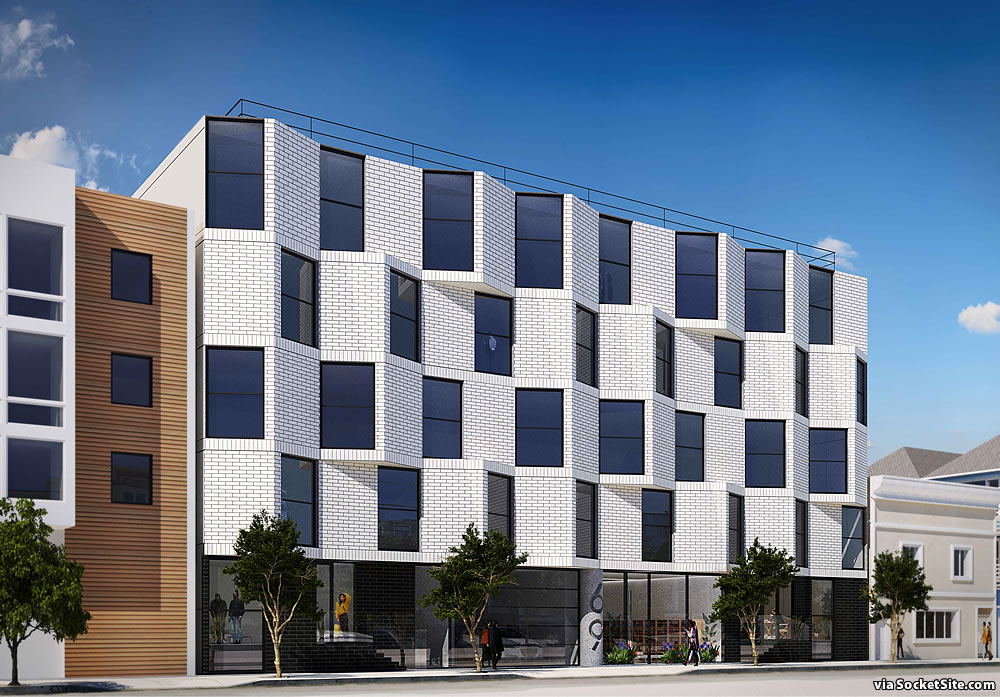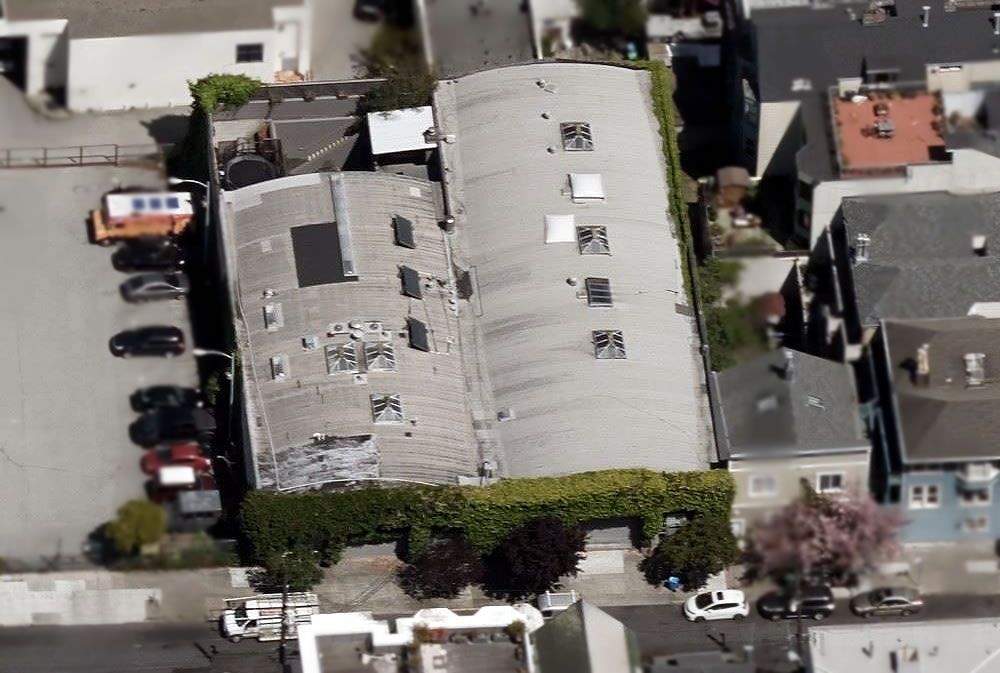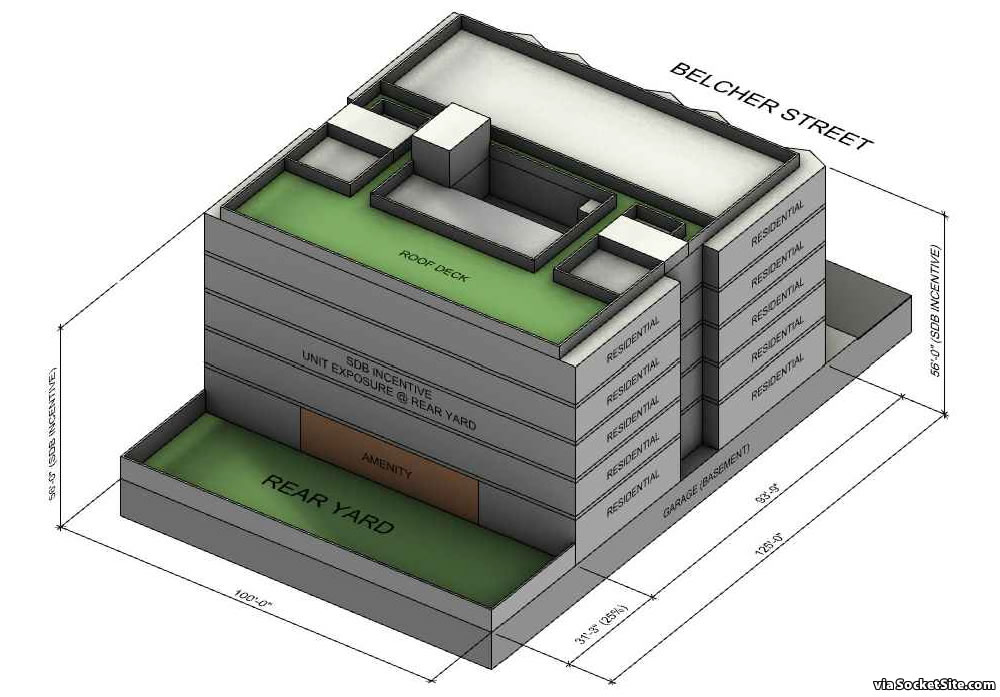The formal application for approval to raze the former furniture warehouse turned art gallery (67 Belcher) and designer loft (69 Belcher) and develop a modern five-story building on the 12,500-square-foot Duboce Triangle site has been submitted to Planning.
As designed by Stanley Saitowitz | Natoma Architects and further refined since we revealed the plans earlier this year, the proposed 54,000-square-foot development would rise up to 56 feet in height across the site and yield 31 residential units, with 1 one-bedroom, 19 twos and 11 three-bedroom units over a basement garage for 15 cars, with a 2,900-square-foot rear yard and a 1,350-square-foot roof deck.
And as the neighborhood site is only zoned for development up to 40 feet in height and 10 fewer units than proposed, the project team will be seeking a Density Bonus to proceed.



Eliminate the parking spaces. If there must be a garage, put in only a couple car-share spaces, an EV charging station, and lots of bike parking.
This project is steps from Church and Market, a transit hub if there ever was one, plus 2 large grocery stores and other services. Best to sell residences in this area to families who won’t exacerbate transit and traffic by driving everywhere.
Agreed. This is a great location for car-free living. All this parking drives up the cost of building and reduces the amount of housing that can be built here.
You seem to be under the impression that “don’t provide parking” is synonymous with “the residents won’t own cars.” I haven’t seen any evidence of that being true, particularly when they can just apply for neighborhood parking permits and compete for street parking with everyone else.
I think it’s pretty realistic to create parking spaces for half of the units, probably charge an arm and a leg for them, and hope that half the residents will take the hint and not have a car.
This. Let the market dictate. If the developer can create *off*-street parking spaces and charge for them, I fail to see the issue. This isn’t some suburban or Dallas development where there are 2x spaces per resident; this is making *some* parking spaces for the inevitable car owners.
I live in the Inner Richmond, and bike virtually everywhere in the city, including bike commute downtown in the beforetimes – but I own a car for weekend trips, hardware store trips, and evening dinners across the city or in the East Bay. The mere fact of owning a car is not a mortal sin, and development should recognize the reality of how people live.
Well, here’s evidence in a study that shows fewer parking spots translate to less car ownership. I don’t think anyone has ever contended that if you build zero parking spots, you’ll get exactly zero car ownership.
Seems to need about 16 more parking spaces.
Better, 15 less. This is a transit rich spot in the city. You don’t need a car to live here.
A resident not *needing* a car does not equal a resident not *having* a car. Kudos to the developer for not sloughing off parking demand to the streets as an externalized cost.
It wouldn’t really work that way. As someone who used an SFMTA parking permit for years living in small scale apartments, something people might not realize is that those kinds of parking permits are only eligible to residents of certain sized buildings. Duplexes and older apartment buildings with maybe single digit unit counts are generally eligible, but newer larger apartment buildings like this do not have eligibility for their residents to apply for street parking permits. You either pay for the onsite parking, find nearby rental parking, or you just don’t drive.
In which case offering on-site parking here makes the units more desirable (i.e., supporting a higher price) to those who do need a parking space. So presumably the developer pencils that out, and decides whether and how many parking spaces to build to maximize their return.
@Sierrajeff You’re completely correct from a financial standpoint, but from the standpoint of being a middle class resident of this city it is beneficial to me to see more housing that does not support parking. I would rather see them maximize the number of residential units to maximize profit rather than see them add more parking to make the same budget work because housing that does not support parking is more affordable to middle class residents.
That said, I do think it is helpful that parking spaces are often sold separately from the housing these days that way the construction costs of these spaces does not get passed along to the renter. Also, side note, increasing parking in a city induces traffic as it increases the number of cars that can physically occupy the city. Building housing without parking reduces construction costs, maximizes space for additional residential units, and does not contribute to traffic. I want to see more housing that supports middle class urban life in this city, and moving in this direction is part of that transition.
That’s actually not true. What you describe is, perhaps, the way it OUGHT to work, but the reality is that there are not any rules in SF around which types of buildings are eligible for street parking permits. If you live in or near a permit area, whether it’s a single family home or in a big new condo building with lots of underground parking, you can buy a residential parking permit—in fact, you can buy FOUR of them—and compete for parking on the street.
The scheme you describe has never existed in San Francisco. I would love to see residents of new buildings unable to buy neighborhood street parking permits, but that’s simply not the case. And spreading false information isn’t a good look.
SB35 it and make it 7-stories!
Hopefully they are over their weird bathroom phase where the toilet, sink and bath are all in separate tiny closet like rooms accessed by sliding doors.
The proposed bathrooms are, in fact, traditional single-room designs versus in-line assemblages of individual closets.
If you follow the links the editor has provided you will be rewarded with an interesting history of this property.
Is this where the Blockbuster used to be? RIP
No.
No, there are (unfortunately) no plans that I am aware of to redevelop that site.
The parking lot behind the old Blockbuster has an entitled project, but it was entitled by Sia Consulting, and they’re wrapped up in the whole corruption scandal (in fact, they seem to be at the center of it) so I don’t hold out much hope that construction will proceed on that one any time soon.
Those demanding that others live in SF without a vehicle must not have spent much time on Muni lately. It is disgusting, often dangerous (particularly on Market St) and certainly not something you can rely on to transport children.
This is a preposterous overstatement.
agree. I would assume that most of people buying those 3bdrooms will have kids. Its very hard to rely solely on public transport if you have kids in school, especially with the lottery system often resulting in kids going to school across town, not to mention all the extracurricular activities. not to mention, exposing kids to dangerous situations with out of control drug addicts and mentally ill that the city is not taking care of…
It is an oft-repeated fallacy that relying on Muni doesn’t work for families with kids. We live in a city that generally helps ensure that one can live here, with kids and family, without a car. And this is very much true if one lives in close proximity to some of the more frequent transit lines. This has worked well for our family and for hundreds, if not thousands, more.
It has worked for many thousands of families, and there is a school bussing system as well.
I live in the area and all my parent friends in the area have two cars. I knew one family that only had one car but they moved away.
I don’t know anyone that uses the bus to take their kids to school. However, both at our elementary school and preschool, bikes and eBikes are very popular. During daylight savings, I bike one of my kids to/from preschool I the mission 2-3 days a week.
In order of frequency, I see parents
Drive
eBike
bike
Walk (sometimes with a kid on a scooter or stroller)
Again, I probably know 100+ parents and I’ve never met one who says they take their kids to school on the bus.
Many (especially slightly older, think 10 and up) kids take buses in SF. You can dispute that fact if you want to, it changes nothing.
Also, sorry to say this, but those yellowish orange things in front of the elementary school around 7:30 a.m. and ~2 p.m. weekdays? Those are things. Those things are called buses.
Pre-pandemic, about half of SFUSD students took transit to school. Most of the rest walked. By car and by bike are much less common. School bus has limited availability based on student need priorities, but thousands of SFUSD students regularly take bus to and from school. There is a regular school bus route serving the nearest SFUSD elementary school to this location in the Mission (Sanchez), but it does not go by or near this location. It goes the other direction all the way to Visitation Valley.
Those big yellow things in front of schools…we and “parents we know” didn’t qualify for because we were too rich and apparently SFUSD has reduced bussing year after year. Seems like there are two kinds of parents whose social circles don’t overlap per these comments…parents who may not qualify for school buses and/or they book their kids with SFrec lessons and immersion preschool and soccer league and swim lessons and whatnot all day long, and their kids are under 10 so don’t take Muni by themselves…and parents whose kids can take school buses or are old enough to take Muni and have plenty of time to wait for Muni…and the question is, which kind of parent is going to buy a 3-bedroom Stanley Saltowitz condo in Duboce Triangle?
Come to think of it, given everything I have heard about Saltowitz’s designs on this website, would any parent want to live in these condos?
Wow, hard to believe that access to school busing is means tested. What a dumb policy. The city should encourage as many kids as possible to take the bus, reducing traffic and chaos around the schools in the mornings and afternoons. Good for parents and good for the city as a whole.
I wouldn’t say it’s means-tested and by saying “too rich” I was being gauche. But school bussing is NOT required by California mandate and so paying for transportation becomes something that could potentially take away funds from more education-oriented stuff (like renaming schools, right?).
Here is SFUSD’s bus policy – it is focused on directing limited transportation funds towards equity, giving priority to underserved students, all laudable and can’t argue with it. And Muni is free for kids. But since none of this applies to a busy, middle-class (for SF), 2-income family with young kids who might be in different schools (say, preschool there, elementary there)–bussing is a non-issue for that kind of family (until at least middle school).
“it works well for me, so how could other people possible complain or want something different?!”
I don’t think there’s anything I can say to convince you otherwise, but most of the city uses public transit on a daily basis including myself and there is a strong demand for more housing near transit for this reason.
do you have a source for that claim. most of the city doesnt use public transit daily.
Certainly not at present.
As to the before times, as someone put it, if we assume most people make roundtrips, and add in usage on other systems, it looks like the technically accurate threshold of “most ” – i.e. 50% +1 – might have been met.
How wrong you are. Every school day, Muni transports thousands, if not tens of thousands, of kids to this city’s schools, in all corners of this city. You must not have spent much time on Muni lately.
“Muni is not safe and reliable” and “Muni transports thousands of students a day” are not mutually exclusive statements.
Glenn, above, wrote that Muni is “certainly not something you can rely on to transport children,” yet it’s relied on by thousands of school kids a day.
While it is possible to get around the city by Muni, someone with a family who is able to afford a 3 bedroom apartment will likely prefer to use a car at times.
I use muni daily to commute and make school runs on the heavily serviced Market Street corridor, however many youth sports and activities are concentrated in the outer areas of the city, e.g. Beach Chalet, West Sunset, Minnie Lovie Field etc. Using Muni to access weeknight activities at those locations typically doubles travel time in each direction and is not very practical. Reality for a family is you either have a car or accept that many city offerings are hard to reach and may be off limits to you.
Bottom line – someone who can afford a 2- or 3-bedroom for their family will probably want a car and parking availability would influence demand for those larger units.
“typically doubles travel time in each direction”
This. Even for Muni’s “express” bus service, I am able to bike from Park Presidio to the Financial District faster – and that’s before factoring the (frequently unpredictable) 5 to 25 minute wait for a bus to show up. (Not an exaggeration; before bike commuting, many’s the time I’d wait at Davis for 20+ minutes waiting for a 31AX *or* 31BX to show up… all for the glory of then having 50/50 odds of standing all the way to the Richmond.)
If you want to surrender that much time of your day to Muni, that’s fine and that’s your choice, but – at the risk of sounding trite, some of us have better things to do that attend to Muni’s foibles and failings.
Yes, biking outperforms almost every bus journey in the city. And for most of the Bay Area as well. Many bicyclists avoid bus routes due to the constant leapfrogging.
I hope Stanley has learned to provide closets and storage space for residential units, including medicine cabinets and counter space in the bathrooms. Are there any designs available for the interiors?
UPDATE: Approved Duboce Triangle Development…Listed for Sale